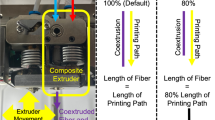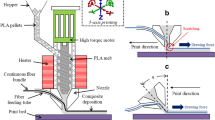Abstract
The current research proposes a novel method for printing continuous carbon fiber composite parts. At first, continuous carbon fiber prepreg filament for Fused Deposition Modeling 3D printing was manufactured, followed by modification of extruder head of 3D printers to print the filament. Thereafter, three-point flexural test and Response Surface Methodology were adopted to study the mechanical properties of the composite parts printed with the filament. After testing, a mathematical model was developed to describe and analyze the relationship between the printing parameters (printing temperature, printing speed, and layer thickness) and the flexural strength of printed composite parts. We discovered that the flexural strength and flexural modulus of printed composites significantly improved with the proposed method with specified printing parameters, and while of all the parameters, the layer thickness had the greatest contribution towards the final flexural strength. The results indicate that the discussed method could be a promising approach to print CCF composites.










Similar content being viewed by others
References
Snyder TJ, Andrews M, Weislogel M, Moeck P, Stone-Sundberg J, Birkes D, Friedman S (2014) 3D systems’ technology overview and new applications in manufacturing engineering science and education. 3D Print Addit Manuf 1(3):169–176
Horn TJ, Harrysson OL (2012) Overview of current additive manufacturing technologies and selected applications. Sci Prog 95(3):255–282
Turner NB, Strong R, Gold SA (2014) A review of melt extrusion additive manufacturing processes: I. Process design and modeling. Rapid Prototyp J 20(3):192–204
Bellini A, Güçeri S (2003) Mechanical characterization of parts fabricated using fused deposition modeling. Rapid Prototyp J 9(4):252–264
Wang J, Xie H, Weng Z, Senthil T, Wu L (2016) A novel approach to improve mechanical properties of parts fabricated by fused deposition modeling. Mater Des 105:152–159
Dul S, Fambri L, Pegoretti A (2016) Fused deposition modelling with ABS–graphene nanocomposites. Compos A Appl Sci Manuf 85:181–191
Prashantha K, Roger F (2017) Multifunctional properties of 3D printed poly (lactic acid)/graphene nanocomposites by fused deposition modeling. J Macromol Sci A 54(1):24–29
Bettini P, Alitta G, Sala G, Di Landro L (2017) Fused deposition technique for continuous fiber reinforced thermoplastic. J Mater Eng Perform 26(2):843–848
Ashori A, Menbari S, Bahrami R (2016) Mechanical and thermo-mechanical properties of short carbon fiber reinforced polypropylene composites using exfoliated graphene nanoplatelets coating. J Ind Eng Chem 38:37–42
Hull E, Grove W, Zhang M, Song X, Pei ZJ, Cong W (2015) Effects of process variables on extrusion of carbon fiber reinforced ABS filament for additive manufacturing. In: ASME 2015 international manufacturing science and engineering conference, American Society of Mechanical Engineers. pp V001T02A065–V001T02A065
Ning F, Cong W, Qiu J, Wei J, Wang S (2015) Additive manufacturing of carbon fiber reinforced thermoplastic composites using fused deposition modeling. Compos B Eng 80:369–378
Tekinalp HL, Kunc V, Velez-Garcia GM, Duty CE, Love LJ, Naskar AK, Ozcan S (2014) Highly oriented carbon fiber–polymer composites via additive manufacturing. Compos Sci Technol 105:144–150
Quan Z, Larimore Z, Wu A, Yu J, Qin X, Mirotznik M, Chou TW (2016) Microstructural design and additive manufacturing and characterization of 3D orthogonal short carbon fiber/acrylonitrile-butadiene-styrene preform and composite. Compos Sci Technol 126:139–148
Li ZH, Rong RY, Li YX, Li J (2011) Effect of fiber length on mechanical properties of short carbon fiber reinforced PTFE composites. In: Advanced materials research, Trans Tech Publications, vol 311. pp 193–196
Ráthy I, Kuki Á, Borda J, Deák G, Zsuga M, Marossy K, Kéki S (2012) Preparation and characterization of poly (vinyl chloride)–continuous carbon fiber composites. J Appl Polym Sci 124(1):190–194
Fischer A, Rommel S, Bauernhansl T (2013) New fiber matrix process with 3D fiber printer—a strategic in-process integration of endless fibers using fused deposition modeling (FDM). In: NEW PROLAMAT. pp 167–175
Prüß H, Vietor T (2015) Design for fiber-reinforced additive manufacturing. J Mech Des 137(11):111409-1–111409-7
Li N, Li Y, Liu S (2016) Rapid prototyping of continuous carbon fiber reinforced polylactic acid composites by 3D printing. J Mater Process Technol 238:218–225
Matsuzaki R, Ueda M, Namiki M, Jeong TK, Asahara H, Horiguchi K, Hirano Y (2016) Three-dimensional printing of continuous-fiber composites by in-nozzle impregnation. Sci Rep 6:23058-1–23058-7
Tian X, Liu T, Yang C, Wang Q, Li D (2016) Interface and performance of 3D printed continuous carbon fiber reinforced PLA composites. Compos A Appl Sci Manuf 88:198–205
Mori KI, Maeno T, Nakagawa Y (2014) Dieless forming of carbon fibre reinforced plastic parts using 3D printer. Proced Eng 81:1595–1600
Bezerra MA, Santelli RE, Oliveira EP, Villar LS, Escaleira LA (2008) Response surface methodology (RSM) as a tool for optimization in analytical chemistry. Talanta 76(5):965–977
Aslan N, Cebeci Y (2007) Application of Box–Behnken design and response surface methodology for modeling of some Turkish coals. Fuel 86(1):90–97
Rankouhi B, Javadpour S, Delfanian F, Letcher T (2016) Failure analysis and mechanical characterization of 3D printed ABS with respect to layer thickness and orientation. J Fail Anal Prev 16(3):467–481
NatureWorks Inc. (2013) Biopolymer 4043D technical data sheet. http://www.natureworksllc.com/~/media/Files/NatureWorks/Technical-Documents/Technical-Data-heets/TechnicalDataSheet_4043D_films_pdf.pdf
Aized T, Shirinzadeh B (2011) Robotic fiber placement process analysis and optimization using response surface method. Int J Adv Manuf Technol 55(1):393–404
Gang ZF, Hong DX, Lin WY et al (2016) Mechanical performance of carbon fiber-reinforced polylactide matrix (C/PLA) composites(I). J Mater Eng 5:16–18
Markforged Inc. (2016) Mechanical properties of continuous fibers. https://markforged.com/ty/download-data-sheet/
Afrose MF (2016) Mechanical and viscoelastic properties of polylactic acid (PLA) materials processed through fused deposition modelling (FDM). Doctoral dissertation, Swinburne University of Technology
Shubham P, Sikidar A, Chand T (2016) The influence of layer thickness on mechanical properties of the 3D printed ABS polymer by fused deposition modeling. In: Key engineering materials, Trans Tech Publications, vol 706. pp 63–67
Acknowledgements
This work was supported by the http://dx.doi.org/10.13039/501100001809 National Nature Science Foundation of China (NSFC) under Grant No. 51405305 and the Shanghai Key Laboratory of Intelligent Manufacturing and Robotics under Grant No. ZK1304. The authors would like to thank the colleges of Aerospace System Engineering Shanghai for their assistance.
Author information
Authors and Affiliations
Corresponding authors
Rights and permissions
About this article
Cite this article
Hu, Q., Duan, Y., Zhang, H. et al. Manufacturing and 3D printing of continuous carbon fiber prepreg filament. J Mater Sci 53, 1887–1898 (2018). https://doi.org/10.1007/s10853-017-1624-2
Received:
Accepted:
Published:
Issue Date:
DOI: https://doi.org/10.1007/s10853-017-1624-2




